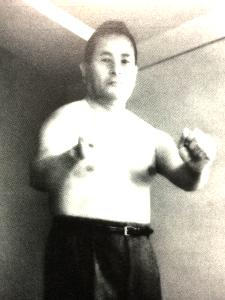There is some confusion as to when Nagamine Shōshin began training in karate under his various sensei. Let’s check the timeline.
It is believed that Nagamine Shōshin entered Tomari Elementary School in April 1914. This is for the following reasons. Nagamine himself wrote,
“When I was in the third grade of Tomari Elementary School, the Naha Ward Elementary Schools Joint Athletic Meet was held at Onoyama Park. At that time, [Funakoshi] Gichin Sensei was teaching at Tomari Elementary School and we schoolboys of 3rd grade and up were taught Naihanchi and Pinan and had a martial arts group performance with more than 200 people. I remember it as if it was yesterday.”
This Athletic Meet took place on November 13, 1916, as reported in the Ryūkyū Shinpō. At that time, Nagamine would have been in his 3rd grade (April 1916 – March 1917). This is confirmed by a photo I was able to take at the Kōdōkan Nagamine Dōjō on May 12, 2009. It is a photo named the “1920 Tomari Elementary School Graduation Alumni Association.” Therefore, there can be no doubt that Nagamine entered Tomari Elementary School in April 1914, and graduated six years later in 1920.
The education system at that time was complicated and there were various routes of education (Shillony 1986: 769-787; MEXT, data for 1908 and 1919). As shown above, Nagamine completed the compulsory 6-year elementary school in March 1920. This was obviously followed by a 2-year higher elementary school or preparatory course for commercial school (compare MEXT, data for 1919), which would have lasted from April 1920 to March 1922.
He then entered Naha Commercial School in April 1922. However, in his second year at Naha Commercial School, he became sick:
“When I was in my second year of [the Preparatory Course for] Naha Commercial School, I suffered from gastrointestinal disorder and was confined to sickbed for more than a year. My complexion was also pale and my weakness was so severe that my school friend misunderstood it as me having pulmonary tuberculosis and were wary of approaching me. At that time, tuberculosis was an incurable disease. I was silently treated by a physician, but it didn’t seem to be effective, so I decided to give up my medicine and concentrate on my diet.”

Shimabukuro Taro
His “second year of Naha Commercial School” would refer to either April–December 1923 or January–March 1924 when he became sick. Or did he just need an excuse to train karate? Anyhow, Nagamine mentioned the year 1923:
“Besides that, as a more non-serious matter, I began to receive instruction in the basics of karate. Elder Kuba Chōjin, who was doing karate in the neighborhood, taught me in the garden of his house. This was in the summer of my 17th year, in the 12th year of the Taishō era (1923).”
Nagamine was in his “17th year,” i.e., he was 16 years old at that time, that is, between July 1923 and July 1924. In other words, he “lost” at least one school year due to illness – or, you could say he won at least one karate year. That means, he would have attended the regular 3-year-course of Commercial School one year longer, namely from April 1922 to March 1926.
At that time, famous karate expert Shimabukuro Tarō from Shuri was also at Naha Commercial School. Nagamine remembered,
“When I asked him if he could teach me karate, he kindly agreed. Since then, when school was over, I would travel the about four kilometers one way to Shuri on a daily basis.”
Accordingly, Nagamine began his study with Shimabukuro around 1924, with some tolerance towards 1925.
So far, so good. In an article by Motobu Naoki Sensei, the following is said about Shimabukuro Tarō:
“Motobu Sensei and Gusukuma Sensei decided they had to show him [Kanō Jigorō] the karate of Okinawa. Therefore, they summoned Shimabukuro Tarō, a fourth-year student at the Commercial School (in Naha), and with permission of the school, they had him demonstrate (the kata) Chintō.”
This took place in January 1927. Since Shimabukuro is said to have been in his fourth year, he must have entered Naha Commercial School in April 1923, i.e, one year later than Nagamine. One remaining issue here is that the MEXT data for 1919 shows that 3 years were stipulated for commercial schools. Was Okinawan Commercial School a four year term?
Shōshin would have graduated in March 1926, at age 18, and would have turned 19 in July.
But it is said that Nagamine was drafted at the age of 20 and successfully passed the physical examination as a grade-one-conscript. He must have therefore have been drafted between July 1927 and July 1928. According to Yanagihara (2020), Nagamine is considered to have joined the 47th Infantry Regiment in Oita in the winter of 1927. This in turn could mean that there was in fact a fourth year at Naha commercial school in Naha. If so, Shōshin would have graduated in March 1927, at age 19, and would have turned 20 in July. He could have then been drafted to enter the 47th Infantry Regiment in Oita in the winter of 1927.
The point here is that Shōshin studied with Shimabukuro Tarō since 1924, and with Arakaki since 1925 or 26. Summoned by Motobu Chōki and Gusukuma Shinpan, Shimabukuro performed Chintō in front of Kanō Jigorō in January 1927. It has therefore to be considered one of the oldest proven traditions of Chintō in Okinawa.
Just to clarify the magnitute of this tradition, the teaching of this Chintō is at least as follows:
- Kyan Chōtoku taught Arakaki Ankichi
- Arakaki Ankichi taught Shimabukuro Tarō
- Kyan Chōtoku taught Shimabukuro Tarō
- Shimabukuro Tarō taught Nagamine Shōshin
- Arakaki Ankichi taught Nagamine Shōshin
- Kyan Chōtoku taught Nagamine Shōshin
© 2021 – 2022, Andreas Quast. All rights reserved.
